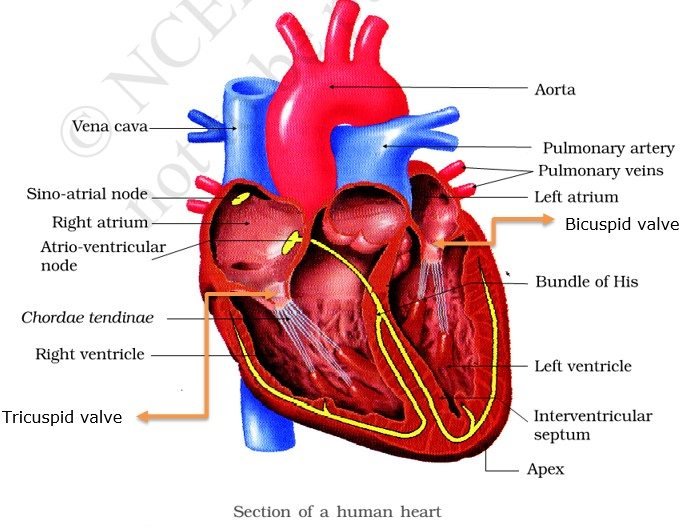Human circulatory system, also called the blood vascular system consists of a muscular chambered
heart, a network of closed branching blood vessels and blood, the fluid which is circulated.
Heart, the mesodermally derived organ, , is situated in the thoracic cavity, in between the two lungs, slightly
tilted to the left. It has the size of a clenched fist. It is protected by a double walled membranous bag, pericardium
enclosing the pericardial fluid. Our heart has four chambers, two relatively small upper chambers called atria
and two larger lower chambers called ventricles. A thin muscular wall called the interatrial septum separates
the right and left atria, whereas a thick-walled, the inter-ventricular septum, separates the left and the right
ventricles. The anrium and the ventricle of the same side are also separated by a thick fibrous tissue called
the atrio-ventricular septum. The opening between the right atrium and the right ventricle is guarded by a valve
formed of three muscular flaps or cusps, the tricuspid valve, whereas a bicuspid or mitral valve guards the opening
of the right and the left ventricles into the pulmonary artery and the aorta respectively are provided with the
semilunar valves. The valves in the heart allows the flow of blood only in one direction, i.e., from the atria to the
ventricles and from the ventricles to the pulmonary artery or aorta. These valves prevent any backward flow.
The entire heart is made of cardiac muscles. The walls of ventricles are much thicker than than that of the atria.
A specialised cardiac musculature called the nodal tissue is also distributed in the heart. A patch of this tissue is
present in the right upper corner of the right atrium called the sino-atrial node (SAN). Another mass of this tissue
is seen in the lower left corner of the right atrium close to the atrio-ventricular septum called the atrio-ventricular
node (AVN). A bundle of nodal fibres, atrio-ventricular septum bundle (AV bundle) continues from the AVN which
passes through the atrio-ventricular septa to emerge on the top of the interventricular septum and immediately
divides into a right and left bundle. These branches gives rise to minute fibres throughout the ventricular of the
respective sides and are called purkinje fibres. The SAN can generate the maximum number of action potentials,
i.e., 70-75 min, and is responsible for initiating and maintaining the rhythmic contractile activity of the heart.
Therefore, it is called the pacemaker. Our heart normally beats 70-75 times in a minute (average 72 beats min).

Congratulations @rahultech! You received a personal award!
You can view your badges on your Steem Board and compare to others on the Steem Ranking
Vote for @Steemitboard as a witness to get one more award and increased upvotes!